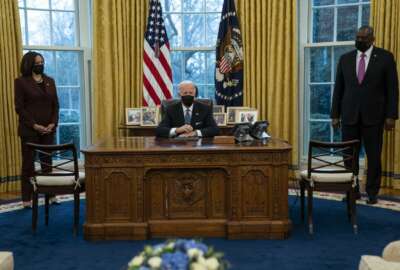Biden administration details its vision for agency reopening, post-pandemic telework
The Biden administration on Thursday lifted the cap on the number of federal employees who can work in the office, but agencies must first submit and finalize...
The Biden administration has lifted the 25% occupancy limit at federal buildings, though agencies must still jump through several hoops before bringing more employees back for in-person work.
The Office of Management and Budget, along with the Office of Personnel Management and General Services Administration, on Thursday issued detailed guidance on the administration’s approach for reopening agency offices during the pandemic — and offered a highly-anticipated glimpse at their approach for telework, remote work and other workforce flexibilities in a post-pandemic world.
“OMB, OPM and GSA expect that agency decisions in these areas will be equitable and grounded in values that empower, respect and galvanize the federal workforce, while reflecting and emphasizing trust and accountability for the American people they serve,” the new guidance reads. “In making decisions regarding post-reentry personnel policies and the work environment, agencies should also consider broader workforce and workplace trends and the need for the federal government to be competitive for top talent as employers in the broader labor market.”
Maximum telework policies remain in effect, as do individual agencies’ COVID-19 workforce safety plans, OMB said Thursday.
Vaccination is not a pre-requisite for federal workers and contractors to return to in-person work, OMB said, and agencies shouldn’t ask employees about their vaccination status. Employees can volunteer that information if they choose, and agencies can use that information to implement masking and physical distancing policies.
Though it’s not currently a requirement, the Biden administration is strongly encouraging employees and contractors to get vaccinated. Agencies can grant paid time off to employees to receive the vaccine or recover from any adverse reactions.
And while the occupancy limit OMB set back in January is, technically, no longer in effect, agencies must complete and submit a phased reentry plan to the Safer Federal Workforce Task Force before increasing the number of employees who can return to work in-person.
The task force will ensure those agency reopening plans meet current guidelines. Draft plans are due to OMB by June 18, and a phased schedule for bringing more employees back to work in person is due by July 9.
Final plans are due to OMB by July 19.
In addition, agencies must meet applicable collective bargaining obligations and give employees enough advanced notice before increasing the number of people that can work on-site.
OMB suggested 30 days advanced notice for employees returning to work, but that number may vary depending on individual situations.
“Employees will need ample time to address these arrangements and other considerations such as transportation as they plan to reenter the physical workplace, start new schedules, or otherwise adjust to new work environments, at the same time that regular child care, elder care, other dependent care, and regular transportation options may remain unavailable or complicated as a result of COVID-19,” the guidance reads.
New employees who have been authorized to work remotely may need more time to work remotely, while parents with school-aged children may need to change their schedules in the fall, OMB suggested.
Of course, there are exceptions.
“An agency may, on a limited basis, increase the number of employees or contractors in the physical workplace prior to taking one of those steps where necessary to meet urgent, mission-critical need —any such action must be approved by the head of the agency, in consultation with OMB and OPM,” the guidance reads.
Federal employee unions on Thursday applauded the new guidance from the Biden administration, which reiterates — on multiple occasions — agencies’ obligations to bargain and consult with labor before bringing workers back to their offices.
“We’re happy to see that the administration is not rushing or imposing any kind of uniform schedule but rather allowing agencies time to work with us for a safe re-entry that incorporates the lessons learned about both the advantages and disadvantages of telework,” Everett Kelley, national president of the American Federation of Government Employees, said in a statement.
‘Clear and immediate need’ to reimagine workforce policies
The Safer Federal Workforce Task Force, which the president established via executive order on his first day in office, has offered up small bits of guidance to agencies since January. OPM teased forthcoming guidance on telework and remote work earlier this spring, and several agencies have said they’re considering workforce policy changes.
But Thursday’s memo, signed by acting OMB Director Shalanda Young, acting OPM Director Kathleen McGettigan and acting GSA Administrator Katy Kale, provides the most comprehensive look at the Biden administration’s thinking on the future of work to date.
The future, as broadly described by the three agencies, will likely look much different than it did before the pandemic started last March.
Given employees’ experiences and workforce trends from the last 15 months, the administration expects agencies will implement new policies that reflect a “hybrid” workforce environment.
“As agencies plan for reentry and post-reentry, there is a clear and immediate imperative to reimagine our policies and practices to reflect new realities and effectively serve the American people,” OPM said in its portion of the guidance.
Many federal employees will continue to work in-person or may return to their offices, OMB said. For these employees, telework or flexible work schedules should still be an option, more so than it was before the pandemic started.
Other employees — again, more so than prior to the pandemic — will engage in a mix of telework and on-site work.
“Employees who have been teleworking during the pandemic generally will remain eligible for telework, at least on a situational basis,” the agencies said. “In many cases, agencies and sub organizations will allow and plan for an increased ratio of telework over onsite work, for more employees, as compared to agency work environments prior to the pandemic. Such arrangements might include, for some employees, a balanced mix of working offsite and onsite, including to satisfy business operations, teambuilding, and other needs. For other employees, such arrangements could mean teleworking a majority of the time or nearly full-time, with a requirement for employees under the General Schedule to report to the agency worksite at least twice each pay period to receive the locality rate associated with the agency worksite.”
The National Treasury Employees Union described the new guidance as a “solid start” as agencies plan for the future of work.
“NTEU also agrees that any employee who has teleworked successfully throughout the pandemic — and there are tens of thousands of them — is considered telework eligible from now on, even post-pandemic,” Tony Reardon, the union’s national president, said. “This is an important distinction that will allow telework programs to be expanded wherever possible.”
For others, remote work for certain individuals or occupations will be an option, the administration said. Agencies may pilot remote work programs and then examine the results to ensure employees are performing up to par.
Notably, federal employees on a remote work arrangement will receive the locality pay rate associated with the location of that worksite, not the location of the agency, OPM said.
The administration’s new workforce policy guidance is the culmination of months of work, with OPM, OMB and GSA leading discussions with the President’s Management Council, chief executives’ councils and other stakeholders. The PMC formed a new working group on reentry and the future of work to collect feedback and ideas from agencies.
The Biden administration acknowledged: Agencies won’t transform their workforces overnight.
Supervisors will need more resources for managing a hybrid workforce, and agencies may need additional funding and IT investments to support an environment where their employees can collaborate from multiple locations.
More telework and remote work also poses big questions about federal property. In its own guidance, GSA suggested agencies consider “untethering federal work from geographic locations and/or specific buildings where possible and appropriate, to the benefit of equity, inclusion, and
mission delivery.”
Broadly speaking, agencies’ new policies should promote a flexible and agile workforce, one where supervisors and employees can simultaneously meet their missions and manage a work-life balance, the Biden administration said.
They should also consider what impact new policies have on the local community and economy — and how they’ll improve diversity, equity, inclusion and accessibility in the federal workforce, the administration said.
Copyright © 2025 Federal News Network. All rights reserved. This website is not intended for users located within the European Economic Area.
Nicole Ogrysko is a reporter for Federal News Network focusing on the federal workforce and federal pay and benefits.
Follow @nogryskoWFED







